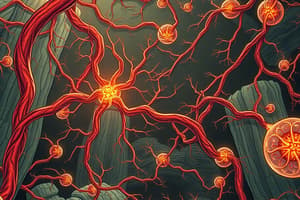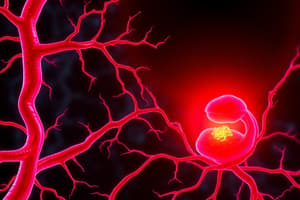Podcast
Questions and Answers
Which of the following is NOT a step in angiogenesis?
Which of the following is NOT a step in angiogenesis?
- Migration of endothelial cells toward a stimulus
- Proliferation of endothelial cells
- Basement membrane degradation by proteolytic enzymes
- Differentiation of pericytes into endothelial cells (correct)
What is the role of VE-cadherin in angiogenesis?
What is the role of VE-cadherin in angiogenesis?
- Inhibiting the migration of endothelial cells
- Stimulating endothelial cell proliferation
- Loosening of pre-existing endothelial cell junctions (correct)
- Promoting basement membrane degradation
During tumor angiogenesis, what is a characteristic difference between normal and tumor-associated endothelial cells?
During tumor angiogenesis, what is a characteristic difference between normal and tumor-associated endothelial cells?
- Tumor-associated endothelial cells proliferate at a slower rate.
- Tumor-associated endothelial cells proliferate 50-200 times faster. (correct)
- Normal endothelial cells have discontinuities that allow haemorrhage.
- Normal endothelial cells exhibit more structural defects.
What is the significance of the vascular phase in tumor development?
What is the significance of the vascular phase in tumor development?
What is intussusception in the context of angiogenesis?
What is intussusception in the context of angiogenesis?
What characterizes the avascular phase in tumor growth?
What characterizes the avascular phase in tumor growth?
How does the growth of spheroidal tumors differ from tumors implanted on the rabbit iris?
How does the growth of spheroidal tumors differ from tumors implanted on the rabbit iris?
What is vascular mimicry in tumor vascularization?
What is vascular mimicry in tumor vascularization?
Which of the following characterizes tumor blood vessels?
Which of the following characterizes tumor blood vessels?
What role does nitric oxide synthase (NOS) play in angiogenesis?
What role does nitric oxide synthase (NOS) play in angiogenesis?
Flashcards
Angiogenesis
Angiogenesis
New vessel formation, occurring during embryo development, wound repair and cyclically in the female genital system.
Angiogenesis Development Steps
Angiogenesis Development Steps
Five steps: Basement membrane degradation, endothelial cell migration, proliferation, canalization and perivascular apposition.
Microvessel Growth Mechanisms
Microvessel Growth Mechanisms
New sprouts bud from existing vessels, circulating endothelial progenitor cells participate, endothelial cells bridge the lumen.
VE-cadherin and PECAM
VE-cadherin and PECAM
Signup and view all the flashcards
Angiogenesis Modulators
Angiogenesis Modulators
Signup and view all the flashcards
Tumor Vascularization
Tumor Vascularization
Signup and view all the flashcards
Angiogenic Capability Acquisition
Angiogenic Capability Acquisition
Signup and view all the flashcards
Abnormal tumor blood vessels
Abnormal tumor blood vessels
Signup and view all the flashcards
In situ carcinoma and melanoma
In situ carcinoma and melanoma
Signup and view all the flashcards
Study Notes
- Angiogenesis, or new vessel formation, takes place during embryo development, in postnatal life, in the female genital system cyclically, and in wound repair.
- It is limited in time and depends on the balance between activator and inhibitor systems, maintaining microcirculation in a quiescent state with low endothelial cell proliferation.
- Quiescent endothelium rests on an extracellular matrix (ECM), specifically the basement membrane, which contains laminin and type IV collagen.
- Angiogenesis proceeds in five steps, regardless of the initiating stimulus:
Angiogenesis Steps:
- Basement membrane degradation using enzymes secreted by endothelial cells
- Migration of endothelial cells toward the inducing stimulus
- Proliferation of endothelial cells
- Canalization, branching, and formation of vascular loops to establish a circulatory network
- Perivascular apposition of pericytes and neosynthesis of basement membrane components by endothelial cells and pericytes
- New microvessels develop via:
Microvessel Development:
- Budding from preexisting vessels
- Participation of circulating endothelial progenitor cells
- Intussusception, where endothelial cells in preexisting vessels bridge the lumen
Angiogenesis Dependence
- All mechanisms involve loosening preexisting endothelial cells from junctions, this being maintained by proteins like vascular endothelial (VE)-cadherin and platelet-endothelial cell adhesion molecule (PECAM)
- Angiopoietin-1 (Ang-1) increases junctions with pericytes, while Ang-2 decreases junctions
- Integrins like alpha beta3 govern the attachment to basement membrane proteins
- Local proteinases and their inhibitors are active in all mechanisms.
- Dilation of microvessels, mediated by nitric oxide synthase (NOS), also aids in angiogenesis
- Angiogenesis relies on the balance between positive and negative modulators within the vascular microenvironment.
Tumor Angiogenesis
-
Tumor angiogenesis, essential for tumor progression in growth, invasion, and metastasis, shares similar steps but is uncontrolled and has increased endothelial cell proliferation
-
The avascular phase of tumors has been studied using tumor spheroids and implants Tumor cell mass grows with the cube of radius, while surface area increases with the square
-
Tumor growth reaches a steady state when the area limits nutrient supply and metabolite removal
-
Spheroids are nourished by diffusion and reach a steady state when cell loss equals cell gain, resulting in slow ("dormant") proliferation and no metastasis
-
Conversely, tumors implanted onto angiogenic sites are rapidly vascularized, leading to exponential proliferation and high steady-state levels
-
Mitotic index is inversely correlated with tumor cell distance from the vessel:
-
Cells closest to capillaries have highest index
-
O₂ diffuses to ~150 µm, allowing a capillary (~100 µm long, 20-100 endothelial cells) to support ~10⁴ viable tumor cells
-
Capillary elongation (~800 µm/day) can support ~10⁴ tumor cells/day, indicating an amplification loop for tumor growth
-
The vascular phase corresponds to invasive and metastatic tumors, which have intravasation and colonization conditions
-
Tumor vessels are lined with discontinuous endothelium, favoring cell transmigration
-
To colonize other organs and grow, tumor cells induce further angiogenesis or remain as dormant micrometastases.
-
The vascular phase parallels neoplastic changeover which is the progression of neoplastic or preneoplastic cell capability to induce new vessels.
-
Ultimately, transitioning from avascular to vascular phase allows escape from the "dormant" phase.
Tumor Blood Vessel Characteristics
- Aberrant phenotype and genetic profile
- Chaotic mixture of dilated and tortuous channels lacking features of arterioles, capillaries, or venules
- Arteriovenous shunts
- Excessive branching
- Uneven diameters
- Increased permeability
- Endothelium of tumor-associated cells proliferates rapidly, has discontinuities, and facilitates macromolecule permeability and tumor cell traffic
Basement Membrane and Pericytes
- May have extra layers lacking association with cells
- Pericytes are loosely associated, have abnormal shapes, extend cytoplasmic processes, and have extra layers
- Abnormal vessel structures coincide with altered gene and protein expression
- Findings indicate a specialized tumor endothelial cell transcription profile, which is genetically different from other angiogenesis linked activation patterns
Angiogenesis Role
- Angiogenesis facilitates tumor access to nutrients and oxygen and a way to spread to other parts of the organism
- Other mechanisms contribute to tumor vascularization:
- Recruitment of circulating endothelial precursor cells (EPCs)
- Co-option of pre-existing blood vessels -Vascular mimicry
- Marrow-derived EPCs incorporation into tumor blood vessels is limited in effect
- Glioblastoma multiforme exemplifies co-option, in which tumor cells form cuffs around brain blood vessels
- Ocular melanomas exemplify vascular mimicry, in which tumor cells line spaces filled with red blood cells
- Solid tumors grow in two phases: avascular and vascular
- Dependence on angiogenesis and angiogenic factor release is evidence of progression from neoplastic transformation in tumor growth and metastasis
- Angiogenesis is important for hematological malignancies; increased microvascular density (MVD) in bone marrow indicates the importance of said angiogenesis.
Studying That Suits You
Use AI to generate personalized quizzes and flashcards to suit your learning preferences.



